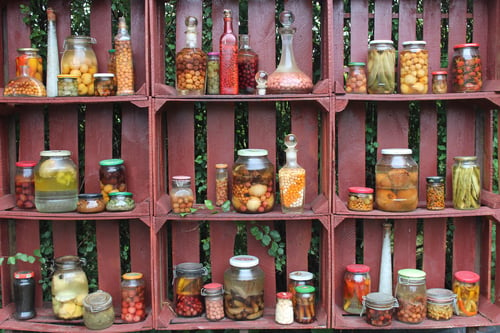 Historically, humans learned that “grab and go” didn’t suffice for long haul nutrition and found functional and innovative ways to make their food last longer. There is evidence that drying foods was used to preserve food as early as 12,000 BC. As time progressed, the ability to cultivate plants and domesticate animals helped increase availability of foods and led to even more creative ways to preserve it.
Historically, humans learned that “grab and go” didn’t suffice for long haul nutrition and found functional and innovative ways to make their food last longer. There is evidence that drying foods was used to preserve food as early as 12,000 BC. As time progressed, the ability to cultivate plants and domesticate animals helped increase availability of foods and led to even more creative ways to preserve it.
Processes like fermentation and pasteurization helped create longer lasting wines, beers, and cheeses. The pickling process extended shelf life by immersing foods in salty or acidy liquids that also slowed the growth of microorganisms. Canning emerged in the early 1800s as a way to preserve foods -- ranging from meats to vegetables and fruits -- through processes involving high heat, sterilization, and sealing.
The purpose of food preservation was to extend edibility by delaying spoiling—a process we now know is caused by decomposition of plant and animal material due to enzymes, microorganisms, and time. These innovative food preservation techniques have remained with us and have been perfected to extend the shelf life of a variety of different foods across the globe.
Pulse crops like beans, peas, and lentils are no exception. Pulse crops can be canned commercially, canned individually at home, and even pickled. Benefits of preserving your own food includes saving money and the health and satisfaction that comes with eating foods that are free from added salt and chemicals.
While drying is a tried and true method for preserving various crops extending the shelf life of certain cooked beans, peas, and lentils for as much as a year. Pulses – the edible dry seeds of legumes – are harvested dry and readily available for retail purchase. Dried pulses are significantly less expensive than commercially canned versions.
While many pulses require soaking in advance, lentils do not. With dry pulses such as beans, peas, and chickpeas, the consumer is definitely trading cost for convenience, as soaking and cooking takes time. According to GrowAGoodLife.com, soaking can be done overnight (roughly 12 hours) to rehydrate or accomplished by using a “quick-soak” method where pulses are placed in boiling water for several minutes and then allowed to soak for approximately an hour before cooking.
For best results, follow the directions on your purchased pulses.
Canning options depend on the size, type, and variety of pulses. Although buying canned pulses is more convenient than rehydrating dried pulses, those looking for a frugal way to extend their food storage can soak, cook, and can their own store-bought dried beans, peas, and lentils. Canning can double the shelf life and has the added benefit of avoiding the added sodium and chemicals found in commercially canned foods.
Once properly soaked, pulses for canning should be precooked and kept warm while canning supplies are prepared. Once canning jars are filled, they must be properly processed in a pressure canner to ensure that the food is safely preserved. For those new to canning, the USDA’s National Center for Home Food Preservation is a good place to start for tips!
Pickling preserves food by fermentation in brine or immersion in vinegar. The process changes the texture, taste and flavor of foods while lowering the pH to a point sufficient to suppress bacterial growth. Pickling can preserve vegetables, fruits, meats, fish, dairy and eggs, as well as pulse crops. As with canning, it’s best to research the process if you are looking for long term storage.
For those looking for an easy introduction, check out AlbertaPulse.com for a few recipes for some quick and easy pickled pulse dishes. Recipes include Vietnamese Pickled Yellow Split Peas, Cider Maple Pickled Green Lentils, and Pickled White Kidney Beans. For those a little less adventurous, SBCanning.com has a classic Pickled Three Bean Salad that’s a more traditional crowd pleaser.
